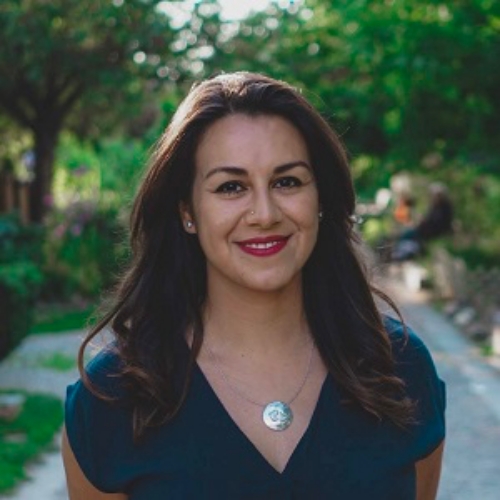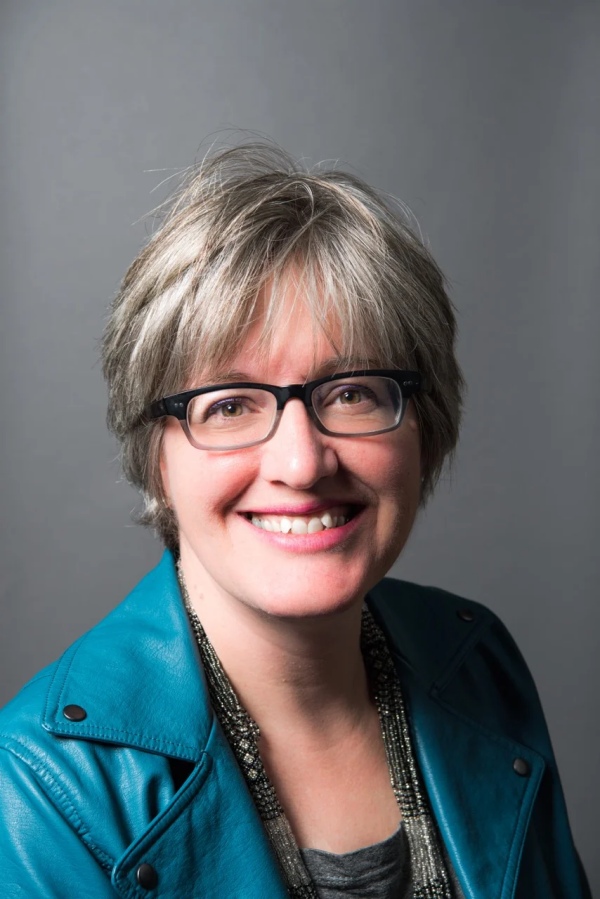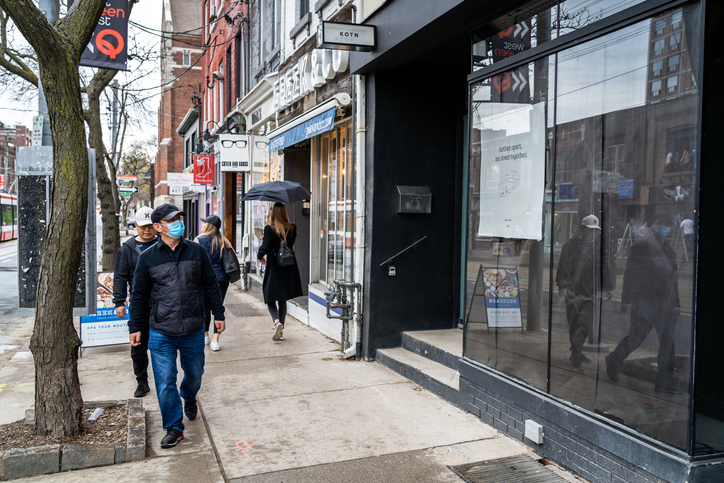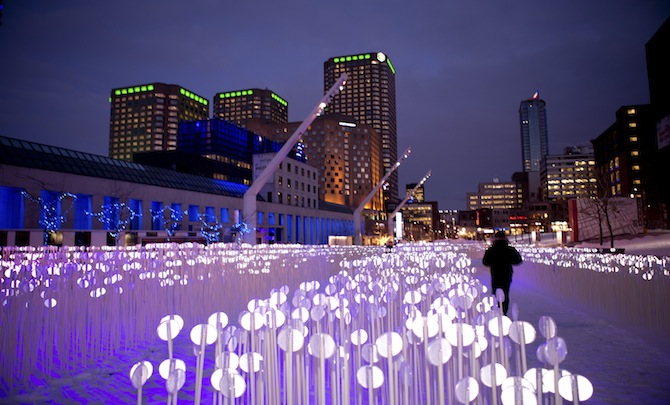Featured Guest
You’ll find this guest among our growing roll of Urban Champions.
-

Shadi Shami
Success Mindset Coach
-

Paty Rios
Senior Public Space Stewardship Planner, City of Vancouver
-

Lucenia Ortiz
Planner, City of Edmonton
-

Diane Dyson
Interim Vice President, Research & Advocacy, Daily Bread Food Bank
5 Key Takeaways
A roundup of the most compelling ideas, themes and quotes from this candid conversation
1. Building dense living environments leads to social connectedness
We must rethink urban design and look beyond public spaces to build close connections with the wider community. Paty Rios, housing expert and research lead at Happy City in Vancouver tells us that multi-unit housing developments and changed living circumstances can capture social connectedness and bring people together. She believes that in designing and planning our city buildings differently, we can enable accidental encounters. These encounters will foster belonging and attachment to help combat isolation and loneliness. Paty says, “We have put all of our eggs in public space as our only basket.” Multi-family housing and denser cities can solve urban isolation and loneliness while addressing affordability issues. Cities can amplify the voices of vulnerable populations and underrepresented minorities by involving them in the co-creation process. It also allows city builders to create spaces that allow for intimate encounters with neighbours and the larger community.2. The newcomer experience and loneliness
“Newcomers will feel like a stranger in a new city,” says Shadi Shami, Success Mindset Coach and steering committee member of the Together Project in Mississauga. Shadi advises newcomers who experience loneliness and isolation to acknowledge those feelings and act because loneliness can impact our physical and mental well-being. Lucenia Ortiz, a retired urban planner and board member of Multicultural Health Brokers in Edmonton says that the loneliness and isolation newcomers experience can be viewed in three realities:- newcomers experiencing inequities when striving for a better life
- their desire for belonging in a new homeland
- experiencing unfilled dreams and expectations
3. The COVID-19 pandemic has exacerbated loneliness and isolation in cities
“The pandemic definitely has amplified these feelings of isolation and loneliness,” said Lucenia. The emergency lockdown measures in Canadian cities has led to the disruption of social connections. To mitigate the social disruptions, we see community members working hard to foster a sense of belonging and social connectedness in their neighbourhoods. Paty notes the musicians playing in their front yards, people appropriating the green space between the sidewalk and the street for gardening and using their rooftops for small gatherings, as ways to overcome loneliness and social isolation. The pandemic has also encouraged people to seize spaces in the city that aren’t very useful and put something dynamic in them. These spaces can help build resilience in cities and help individuals tackle urban isolation and loneliness.4. Dynamic urban policies help build social connections
“At a policy level, there are a couple kinds of connections that people need to have,” says Diane. People need to have close bond connections, for instance, someone to call at 3:00 a.m. if they need to. They also need looser connections, such as connections to their neighbours or people they pass on the elevator. Diane elaborates, that the theme of belonging is an important consideration for policymakers as they think through built form. “In Canada, policies are actually one of the big barriers,” says Paty. She conducted a study called Design to Engage where six big moves were identified to bring people closer together through the design of multi-unit housing. Paty questioned various community stakeholders including planners, architects, designers and developers about their inability to implement these big moves and 80 percent of them said that “It’s a policy thing.” Paty acknowledges that policies do take time, so we need to identify the low hanging fruit and start working on them. She also highlights the importance of pushing for new, dynamic policies that help build social connections moving forward.5. Neighbourhoods are our final destination
We need to look at our neighbourhoods and see what we can do better to build connections. Lucenia says, “It’s in neighbourhoods, our village, a safe space where we can be ourselves and feel a sense of community.” She advocates for more inclusive neighbourhoods and designing neighbourhoods that meet the evolving needs of everyone in the community. Lucenia points to immigrants living in multigenerational households to make her case. She says that in young families, it is grandmas that watch the kids and bring them to the playground, however, not all playgrounds are designed to meet the needs of grandmas. They don’t have benches or other amenities that can help facillitate connections and reduce loneliness. We need to listen to the needs of our community. Diane says, “My plea is that we think about changing the built form so that people can live there at different life stages.” It is important that people feel connected to their neighbourhoods, so they aren’t left feeling lonely and isolated. According to Paty, evidence shows that “…people who are connected can live up to 15 years more, they can overcome cancer more easily, they are less likely to have a heart attack and they are more likely to participate in community events and be an active part of the community life and political life of a city.”Full Panel Transcript
Note to readers: This video session was transcribed using auto-transcribing software. Manual editing was undertaken in an effort to improve readability and clarity. Questions or concerns with the transcription can be directed to events@canurb.org with “transcription” in the subject line.
Full Audience Chatroom Transcript
Note to reader: Chat comments have been edited for ease of readability. The text has not been edited for spelling or grammar. For questions or concerns, please contact events@canurb.org with “Chat Comments” in the subject lin
From Canadian Urban Institute: You can find transcripts and recordings of today’s and all our webinars at https://canurb.org/citytalk
00:30:26 Canadian Urban Institute: Welcome! Folks, please change your chat settings to “all panelists and attendees” so everyone can see your comments. Attendees: where are you tuning in from today? 00:31:01 Canadian Urban Institute: CUI extends a big thank you to our partner for today’s session, the Goethe-Institut Toronto! Join the Goethe-Institut this week for GOETHE FILMS @ digital TIFF Lightbox: A Lonely City, streamable now until May 19, 6pm Neubau, streamable May 21-23 Tickets at digital.tiff.net/page/goethe-films/ 00:32:31 Abigail Slater (she/her): Hello from Tkaronto. Two seasons. Winter and construction. 00:33:08 Lorne Cappe: Tuning in from Toronto. Thanks for doing this session. 00:34:01 Kirsten Frankish: Hello from Whitby – traditional territory of the Mississaugas of Scugog Island. 00:34:03 Jutta Brendemuhl: … two seasons: leaf blower and snow blower! For me, noise is actually part of a conversation on how we feel & act together in our cities… 00:34:11 Toby Greenbaum: Hello from Ottawa. It’s a beautiful day. 00:34:36 Susan Fletcher: Hi Diane Dyson — so nice to see you! 00:34:39 Laurel Davies Snyder: Hello from Stratford, ON. 00:34:59 LEASA GIBBONS: Hello from Regina! Looking forward to this conversation. 00:35:04 InGi Kim: Hello from Edmonton! 00:35:46 Maria Alonso Novo: Hello from Madrid 🙂 00:35:58 Jenna Dutton: Good morning/ Hello from Calgary! 00:36:17 Canadian Urban Institute: Connect with our Panel: Diane Dyson, Senior Director of Research and Engagement @Diane_Dyson https://www.linkedin.com/in/diane-dyson/ Lucenia Ortiz, Urban Planner and Board Member at Multicultural Health Brokers in Edmonton @LuceniaO https://www.linkedin.com/in/lucenia-ortiz-22246970/ Paty Rios, PhD, Housing Expert & Research Lead at Happy City in Vancouver @riospaty https://www.linkedin.com/in/paty-rios-47996aa0/ Shadi Shami, Steering Committee Member, Toronto’s Together Project and Success Mindset Coach in Mississauga. @ShadiShamiCoach https://www.linkedin.com/in/shadi-shami-4259a837/?originalSubdomain=ca 00:37:21 Lisa Cavicchia: https://thehappycity.com/resources/happy-homes/ 00:40:44 Lisa Cavicchia: https://citysharecanada.ca/ 00:42:26 Abigail Slater (she/her): Perhaps also differentiate between being alone/aloneness and loneliness. 00:46:32 Abigail Slater (she/her): I said that above in relation to what Patty said about the need for space to be alone (if I understood her properly) as well. Which speaks to physical space design. 00:47:12 Camila Fisher: Shadi, thank you for those great points. Loneliness can exist in any place or time regardless of situations (e.g. COVID) 00:47:14 Canadian Urban Institute: We love your comments and questions in the chat! Share them with everyone by changing your chat settings to “all panelists and attendees”. Thanks! 00:49:39 Yasmin Afshar: Thanks for those remarks, Shadi. I think the experience of loneliness for an immigrant is such a complex experience tied to other aspects of the immigration process. I have been thinking about how feeling like you belong in a community could help those moving to new countries, and how it may be difficult for people to reach this feeling of belonging depending on where they settle because of reasons that Patty mentioned. Really excited for the rest of this conversation! 00:52:03 Jutta Brendemuhl: @Shadi, thank you for these incredibly powerful points about the two-way street that loneliness/belonging is, the learning & teaching, the responsibilities & actions when you negotiate multiple identities (as we all do) 00:53:19 jeffery parker: Loneliness is a normal human emotion which during times of stress can take on heightened significance, like ‘one of the four horsemen of the apocalypse.’ Jeffery Parker, psychotherapist. 00:55:15 Ross Cotton: Greeting from Barrie , Ontario 00:56:23 Abigail Slater (she/her): There is also the loneliness of the elderly- stemming from dispersed families/perceived lack of productivity/and simply in many cases simply forgotten or “warehoused”. 00:57:12 Susan Fletcher: “Now is the [14 month] winter of our discontent” with apologies to Shakespeare 00:58:57 Laurel Davies Snyder: Is there any work on the ratio of integrated/connected public space & access to private space with respect to connections, belonging, etc.? Interested in more information regarding Mary’s referenced to “Islamic urban form embedded to ancient geometry of connection” 00:59:32 Ross Cotton: …and it is more when you have lost your spouse or other loved ones when you cannot have other loved one with you. 01:02:14 Mary W Rowe: @laurel google The Islamic City and you’ll get a ton of references = 01:02:28 Mary W Rowe: ditto sacred geometry and the city 01:02:59 Camila Fisher: Also really interested in The Islamic City. Thank you! 01:03:32 Laurel Davies Snyder: Thanks so much – fascinating to me 🙂 01:04:06 Diane Dyson: Sociologist Eric Klineberg’s book Heat showed that low-income and immigrants who had stronger social ties were more likely to survive the heat wave in Chicago which killed 700+ people. 01:06:29 jeffery parker: Check out: United Nations: Urban lll: Quito 2016; https://www.un.org/sustainabledevelopment/sustainable-development-goals/ J. Parker 01:06:58 Laurel Davies Snyder: Great discussion. Currently working as a Planner in a mid-sized Canadian city, I see that there is increased resistance to the public good and increased support for private space, privacy, and individual rights. 01:07:32 Abigail Slater (she/her): There is also Putnam’s book Bowling Alone which talks about the need for community connection and which communities were tighter and more tolerant. 01:07:40 Abigail Slater (she/her): Of others 01:08:31 Camila Fisher: Laurel, that’s super interesting. 01:11:29 Diane Dyson: In her PhD thesis, professor Sutama Ghosh tells a wonderful story which informed the United Way Toronto research report Vertical Neighbourhoods. She tells the story of going into a building where everyone on the floor left their doors open so the children could come and go, visiting as they please. It gave origin to the idea of a vertical neighbourhood. 01:12:02 Paty Rios (she/her): Yes Diane, Chicago, hurricane Katrina, Mexicos 2017 Earthquake. They show the same relationship: seniors, low-income people, people with a disability living in more connected neighborhoods were more likely to get immediate help. 01:13:51 Diane Dyson: For the record, I grew up in an English enclave in Quebec! 01:14:51 Diane Dyson: Dr. Sandeep Agrawal has done great research on enclaves. 01:15:07 Lisa Cavicchia: Here’s one study: https://www.ualberta.ca/science/news/2018/september/urban-planning-ethnic-communities.html 01:15:25 Paty Rios (she/her): Laurel, why do you think this is happening? 01:16:48 Abigail Slater (she/her): Such an interesting tension-how do we do both. Honor the enclaves while allowing the feeling of belonging. On another CUI panel there was discussion about newcomer communities that don’t allow for upward mobility (re housing) within those communities. These issues seem related. 01:17:05 Lisa Cavicchia: From Robin Dunbar on social distance, co authored with a McGill prof: https://www.sciencedaily.com/releases/2020/06/200609104253.htm 01:19:05 Laurel Davies Snyder: So many reasons and I think this would be a good webinar discussion 🙂 I see a lack of overall dialogue about “the city” and what it means to live in a city (ongoing awareness, etc.), gap between policy and implementation, decision-making models, perception of what results from engagement actually mean (the vocal minority), lack of evidence-based planning, lack of understanding context, political / sociological norms are shifting (e.g. pursuit of individual wealth, etc.). This is just off the top of my head 🙂 01:19:43 Olusola Olufemi: What about wanting to stay away from the ethnic enclaves because of stress, competition, judging and sometimes profiling that might bring about depression? This is the other side of isolation. 01:20:16 Jutta Brendemuhl: @Lucenia, love “neighbourhoods as the final destination” — that for me is really (or at least could be, with appropriate focus and funding) a huge of Canadian cities 01:20:40 Susan Fletcher: Pre-Covid, Gerrard Square shopping mall seemed to function as a space for Asian grandparents looking after young children could hang out on the benches while the pre-schoolers played or napped. I wonder how they are dealing with the isolation now. 01:21:14 jeffery parker: A 2016 conference document from the UN, in 44 languages: on urban planning and development: habitat3.org/the-new-urban-agenda J. Parker 01:22:32 Callista Ottoni: On the importance of benches for older people, in social science and medicine “When Benches Become Porches” https://www.sciencedirect.com/science/article/abs/pii/S0277953616304804 01:23:17 Jenna Dutton: Also interim policy statements and or/ Notices of Motion that can highlight importance of policy focus while larger policy elements are being worked on – i.e.: while engagement is occuring 01:23:51 Jutta Brendemuhl: @Paty getting to (lengthy) policy change: What are everyone’s most urgent policy change recommendations? 01:24:35 Canadian Urban Institute: CUI extends a big thank you to our partner for today’s session, the Goethe-Institut Toronto! Join the Goethe-Institut this week for GOETHE FILMS @ digital TIFF Lightbox: A Lonely City, streamable now until May 19, 6pm Neubau, streamable May 21-23 Tickets at digital.tiff.net/page/goethe-films/ 01:25:02 Canadian Urban Institute: Learn more about the Healthy Communities Initiative here: www.healthycommunitiesinitiative.ca 01:25:31 Diane Dyson: Indeed ethnic enclaves and neighbourhoods have their limits, especially when they trap people! I often think about an introverted colleague who shudders at the thought of knowing his neighbours. Hopefully cities provide something for all. 01:25:53 Camila Fisher: Thank you to all of the panelists and the organizers! Incredible discussion! I appreciate hearing from diverse viewpoints. 01:26:06 Jutta Brendemuhl: Thank you, team Canurb, always a pleasure to collaborate with you — we’re better together! 01:26:39 Canadian Urban Institute: We put together a Spotify playlist for our talk today: https://spoti.fi/3hDHfSA 01:26:43 Lisa Cavicchia: https://canurb.org/publications/covid-signpost-365-days/ 01:27:27 Abigail Slater (she/her): I wonder what people think about new app Nextdoor. 01:27:40 Abigail Slater (she/her): Helpful or harmful? 01:28:15 Kirsten Frankish: Huge thanks to the panelists and the CanUrb team for another thoughtful and thought provoking conversation. Until next time! 01:28:45 Jenna Dutton: Thanks to the panelists for your insights! 01:29:51 Canadian Urban Institute: Join us tomorrow at 2pm ET for a discussion about the concrete steps municipalities can take to help create the community partnerships they need: https://us02web.zoom.us/webinar/register/WN_Y5Pa76QXS7msOZRz4_6_oA 01:30:05 Laurel Davies Snyder: https://slate.com/business/2021/05/los-angeles-low-rise-contest-housing-crisis-affordability-missing-middle.html?fbclid=IwAR0EKZnTlMQkjOUOLy7dPH4D3erGKX8WtsIsOd938JeWJwm3ifBYPaHlaBI 01:30:20 Candace Safonovs: This was a great panel, thanks all! 01:30:27 Laurel Davies Snyder: https://www.bloomberg.com/news/features/2021-05-14/the-post-pandemic-future-of-central-business-districts 01:31:09 Jutta Brendemuhl: Paty, Lucenia, Shadi, Mary & Diane: thank you for the thinking and work you do, this is so inspiring and uplifting, with lots still to discuss and amend 01:31:14 Callista Ottoni: Thank you! Great discussion 01:31:24 Laurel Davies Snyder: Super discussion. thank you everyone. Thank you CUI for these sessions. 01:31:42 Abigail Slater (she/her): Thank you!! 01:31:54 Lisa Cavicchia: Hi Arleigh!


